今日推薦開源項目:《用表情說話 partyparrot》
今日推薦英文原文:《The Learning Funnel》

今日推薦開源項目:《用表情說話 partyparrot》傳送門:GitHub鏈接
推薦理由:現在比起直接打字,有的時候一個精緻的表情包更能夠表達出使用者想要表達的信息。這個項目就可以讓你使用鸚鵡表情包表達你心中所想的文字——因為它真的可以把文字用鸚鵡們來表達出來,文字只是一種符號,並不需要糾結於由什麼組成,而是放眼全局,體會它要表達什麼才是正確的(雖然這群鸚鵡早就毀掉了嚴肅的氣氛……
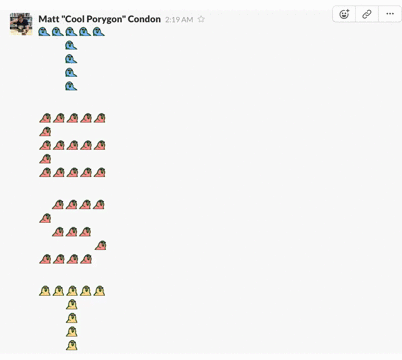
今日推薦英文原文:《The Learning Funnel》作者:Przemek Smyrdek
原文鏈接:https://medium.com/better-programming/the-learning-funnel-ef982e580b4b
推薦理由:一種新的看待技能的方法——分層
The Learning Funnel
Creating a strategy for career learning
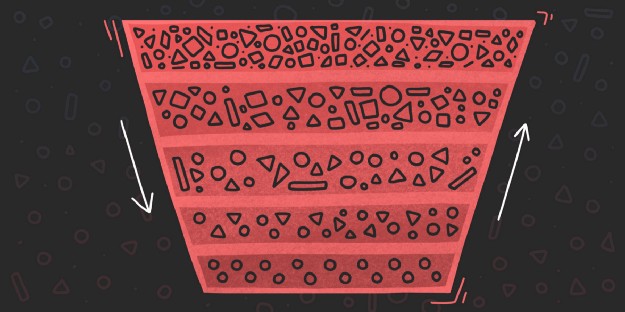
Thanks to all kinds of activities related to software development I』m involved in, from time to time I have a chance to talk to people entering this career path and I listen to their struggles.
One of the issues that regularly arises is caused by the so-called paradox of choice — a situation where the total number of choices one has to face (in terms of technology, programming language or the next best framework) makes it impossible to stay focused on the most important topic and therefore learn efficiently.
Additionally, considering the fact that our industry is full of strong opinions about growth and personal development, it』s pretty hard to define a list of tasks one should complete in order to become a better software developer. Some say attending conferences is a waste of time; there are those who say that there』s nothing of good in a particular book, and of course, there are people trying to convince you of the amazing value that this one tool brings to the table!
Recently, I』ve been trying to figure out a solution for both these issues, which would make it easier for you to find your own learning path in software development. I think I』m finally ready to share my ideas with all of you.
To be specific, it』s time to learn more about the Layered Model of Learning Programming (the name is liable to change).
The Key Question
Let me ask you a question. How many ways are there to start your journey as a programmer?It』s easy to define at least a dozen of them. There is an unlimited number of meetups, conferences, courses, books, articles, boot camps, hackathons or pet projects you could get interested in to learn a bit more about this crazy world of software development.
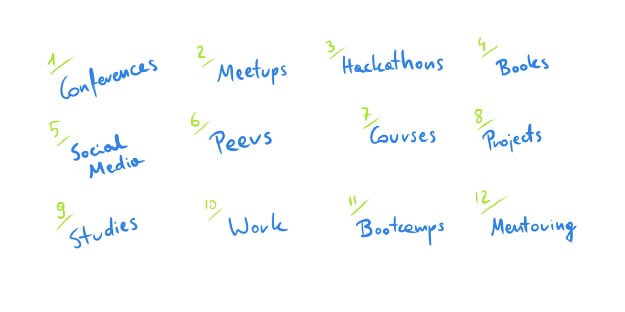
One of the most popular ways to start such a journey is to sign up for a Computer Science class. There you discover and play with languages like Python, Java or C++ for the first time. Some of us, however, decide to skip this step and would rather participate in boot camps or other 「task force groups」 focused on intense courses for software developers.
Parallel to those activities, an ambitious programmer can surround themselves with books written by industry experts, and subscribe to their social media profiles where they might absorb meaningful insights. They might attend a few conferences to learn more about 『the next big thing』. Finally, they reach a point where they can start their first job and finally have a chance to apply the theory in a real situation.
At this point, some of us may feel overwhelmed by the vast number of different paths one could take. It』s a common dilemma that most programmers know: we wonder what is the right order of tasks and activities we should complete to become an expert.
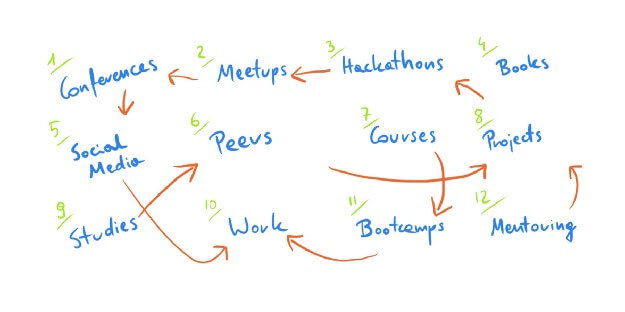
Should I look for a job rather sooner than later? Is attending a conference a good idea, or a waste of time? Do I really need to buy this paid course, considering my current account balance is equal to zero? Is 『Clean code』 a book worth reading for someone like me? What about this new framework that has been published recently — should I learn more about it? Based on my experience mentoring programmers at various stages of their careers I can tell you: these questions are more popular than you think.
The biggest fallacy about learning software development is that for some of us it』s a one-dimensional path where the most important factor is the order of activities we are involved in.
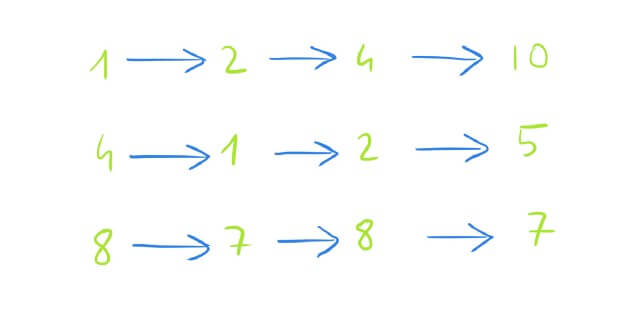
It』s no wonder that such a model does not help us learn and grow without stress, self-doubts, or even anxiety. When the only thing that matters is the order of activities, all we think about is whether we should do this before that, or something else afterward. A book before a course? A talk before a boot camp? A conference after a book? Is XYZ a waste of time? Is XYZ a good choice? And many more…
In general, there are these two questions worth answering to untangle the paths of learning programming:
- What』s the right number of topics I should be interested in at this point in my career? Should I value a broad range of skills over very narrow specialization, or maybe the opposite?
- How much time and effort I should invest in the topic I have in front of me? What』s the good balance between shallow and deep learning, and when to favor one over the other?
The Next Dimension
There are two key goals for everyone who thinks about successful learning and developing their skills in programming:- build competitive advantage by being more experienced and skillful than the average in a small number of well-defined areas, to bring extra value to anyone who wants to work with you
- stay aware of the situation on the market in terms of techniques, practices, frameworks, and languages, to extend your 「expiration date」 as a software developer and to enable cooperation with experts from other domains
After spending many hours trying to figure out a stable learning framework based on these two points, I recalled something that all my friends from the world of marketing and sales use on a daily basis: a sales funnel.
「A sales funnel is a visual metaphor for the path taken by a potential customer as he or she moves towards becoming a customer. Frequently used by sales and marketing organizations, the sales funnel helps companies understand and visualize their sales process and measure overall conversion success between each step of the funnel.
A sales funnel is shaped like an inverted pyramid, similar to real-world funnels, to which the metaphor alludes. The width of each part of the funnel reflects the audience size, with the top of the funnel being the widest and the bottom being the smallest.」
How does it relate to what we』re talking about in this article? Let me surprise you —it relates in a very direct way! The only thing we need to do is to replace 『customers』 with 『topics we want to learn about』 and 『activities we want to be involved in』:
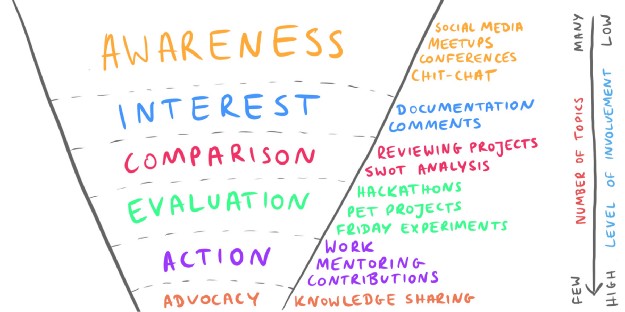
Such a 『layered learning funnel』 can be used by developers to manage the topics they learn about, invest time into them and interact with. The key point about this funnel is that it adds the next dimension to our thinking about learning and growing as a software developer, by introducing this concept of level of involvement.
As it turns out, noticing the difference between the order of things to learn and the level of involvement, gives us a useful model for approaching every new concept, without the need to limit your expertise to areas you』re most familiar with.
To see how all of this works, let me explain the rules of this model.
It』s All About Layers
The concept I want to show you today consists of multiple layers (buckets) for everything that is (or may be) related to your growth: books, courses, talks, conferences, studies, papers, docs, frameworks, languages, etc.Layers in the upper part of the learning funnel may contain multiple topics you just 「collect」 —in order to stay aware of how things work these days, or keep abreast the next big thing for your peers working in different areas of software development (languages you know less about, frameworks you didn』t have a chance to work with, etc.). Layers in the lower part require more effort, but they help you build your expertise and market value.
The most important thing about all these layers is that the deeper you go, the smaller the number of topics you bring with you (because there are a limited number of hours per day), but your level of involvement has to increase (because this is the place to focus and work deeply).
Let』s go through each layer of this funnel to see how it works.
Awareness
This is the bucket for all kinds of activities for people interested in the world of software development — no matter what language, technology, or framework is being mentioned. The awareness layer is about attending conferences, talking to people at meetups, following social media profiles or just briefly reading some docs only to stay aware of everything that happens around you. Relatively low level of involvement, but a wide range of topics to cover.Interest
There are some topics in the previous layer that may look especially interesting for you. For example, at one conference you listen to the talk about this brand new framework you have to check or maybe someone mentions this great language that BigCo uses daily, and you decide it』s worth spending some time on it. You filter out some of the topics from the Awareness layer only to briefly check how does this new tool looks from your own perspective.Comparison
The Comparison layer contains all of the topics that fight really hard for your attention and which are promising in real life. This is where you compare shiny new toys with tools you use to build stuff every day. This is the time to think about their weaknesses, bad parts, the context in which they need to work and the value that this specific framework, language or technology brings to the table. This is the layer that ends our dry analysis of a given subject, because everything that comes next is mostly about practical application.Evaluation
It』s time to check how your topic of choice works in reality. For example, you can create a repository for a demo project where you test this newly discovered practice or framework. You may introduce it in one of your pet projects, or even build an MVP based on it. The key thing is that at this stage the risk of introducing this brand new tool should be relatively low — all in all, you』re only evaluating it without making any final decisions.Action
Everything that lands in the Action layer can be immediately propagated to your portfolio, LinkedIn profile or your summary of expertise. The Action bucket is a place where we keep languages, techniques, and practices that help us build stable, reliable solutions in which risk is minimized. Topics we put in this bucket are never a waste of time. They』re directly related to our daily job, the projects we work on and the reasons we get paid.Advocacy
The Advocacy layer is totally optional for most programmers, but the value it brings forces me to include it among others.So what』s inside it?
Well, from time to time we discover something from these 「actionable」 buckets that makes us so excited that we can』t wait to share it with our colleagues or the community. We start promoting it on the web, we talk about it at conferences, or we record a video explaining the basics of it. In some companies, we』d be called 「evangelists」 of this specific topic. Activities from this layer are often very time-consuming but the return of investment from them can pay off in a meaningful way (building a personal brand, meeting experts and sharing knowledge with them, or even building a foundation for everything that comes next for you).
Show Me How It Works
My learning funnel, as a front-end developer working mostly with Angular projects, looks like this: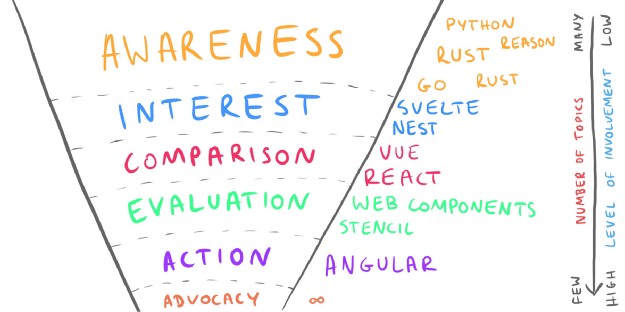
What』s in my Awareness layer? Basically the whole world of software engineering! I』m really eager to learn about new languages, techniques or frameworks. I love to follow social media sh#tstorms about all kinds of stuff and debates. I want to stay aware of things, I want to be prepared for changes that are possibly waiting for me in the future, and I want to discover new worlds without that much involvement.
In the Interest layer, there are mostly topics related directly to my front-end experience. As of today, I』m following the development of the Svelte framework. I』m curious how it will change the way we write our client-side solutions and I can』t wait to spend more time on this topic. The same with Nest, which seems to be a really promising replacement for raw Node.js environment.
Comparison? Of course two out of 「the big three」: Vue and React. Even though I spend most of my professional time in front of Angular, I』m passionate about new ideas released under both green-ish and blue-ish logotypes. I read about hooks, I read about single-file components, and I』m trying to borrow some of those ideas to the world I』m the most familiar with, which is Angular.
The Evaluation layer is currently all about Stencil and Web Components. I』ve managed to release a few production-grade projects based on these two and I』m constantly looking for more knowledge in those areas. Some time ago I fell in love with the idea of building truly reusable components, which can be injected into your favorite front-end technology. I had a chance to not only build WC-based solutions but also discuss different ideas and issues with Stencil』s core team and other advocates for that wave.
Moving to the Action layer now, where most of the time I build stuff using Angular (and JavaScript in general). This is the framework I feel most comfortable with — so far it has helped me build a few dozen projects, so it』s natural that I put a lot of attention to this part of my professional life. Additionally, as a big fan of solving things from first principles, I try to level up in raw JavaScript, which has saved my life more often than you can imagine!
Last but not least, there』s the advocacy layer. Due to me being a big promoter of the knowledge sharing movement, today you can read this article, watch my videos on YouTube or listen to a talk at a local conference. The total amount of time I invest in these areas is pretty big, and so is the outcome I feel every day.
In your case, all the layers I』ve described will probably include a totally different set of activities. If reading a technical book is a way you build your awareness, surely it will land in a different bucket than in my case. If your daily job gives you lots of space to experiment with different libraries and frameworks, you will also treat these 「risk-related」 activities differently. All in all, it』s not about finding the only way of labeling such activities, such as 「reading a book」 or 「attending a conference」, but rather it』s about learning in this two-dimensional funnel where, next to the order of tasks, we also think about the right level of involvement.
Does it Really Bring Any Value For You?
Yes, it does. Thanks to modeling my own way of learning the craft of software development, everything I do is better structured and better organized. It lets me work on my skills more consciously.For example, thanks to splitting the different activities I』m involved in into layers, I don』t feel guilty after visiting one or two conferences (for me it』s an Awareness layer) just because some people say it』s a waste of time. On the one hand, I understand that it』s a great way of keeping my finger on the programming pulse and staying in touch with bleeding-edge ideas, techniques or frameworks. On the other hand, I』m not that sad after missing one or two events — it won』t ruin my career.
At the same time, as we go into lower parts of the funnel, I know that there』s a need to work on a limited number of topics in a more focused and deep manner. Without clearly defined areas of expertise, I don』t feel as comfortable as I』d like to.
Thanks to this additional dimension (level of involvement) I can approach different activities more consciously and expect different outcomes without being disappointed due to the lack of results. The more I get familiar with something (an idea, a framework, a tool) and the more promising it looks, the more attention I put on learning it and promoting it to latter layers of my funnel.
Additionally, the model I explained here is not a tool that only beginners can include in their workflow, but it』s something that anyone who tries to navigate their career path can use on a daily basis. In the end, the process of learning is endless, so I can』t think about any reason why putting more order into it will get you into trouble.
下載開源日報APP:https://openingsource.org/2579/
加入我們:https://openingsource.org/about/join/
關注我們:https://openingsource.org/about/love/

熟悉的鸚鵡表情包